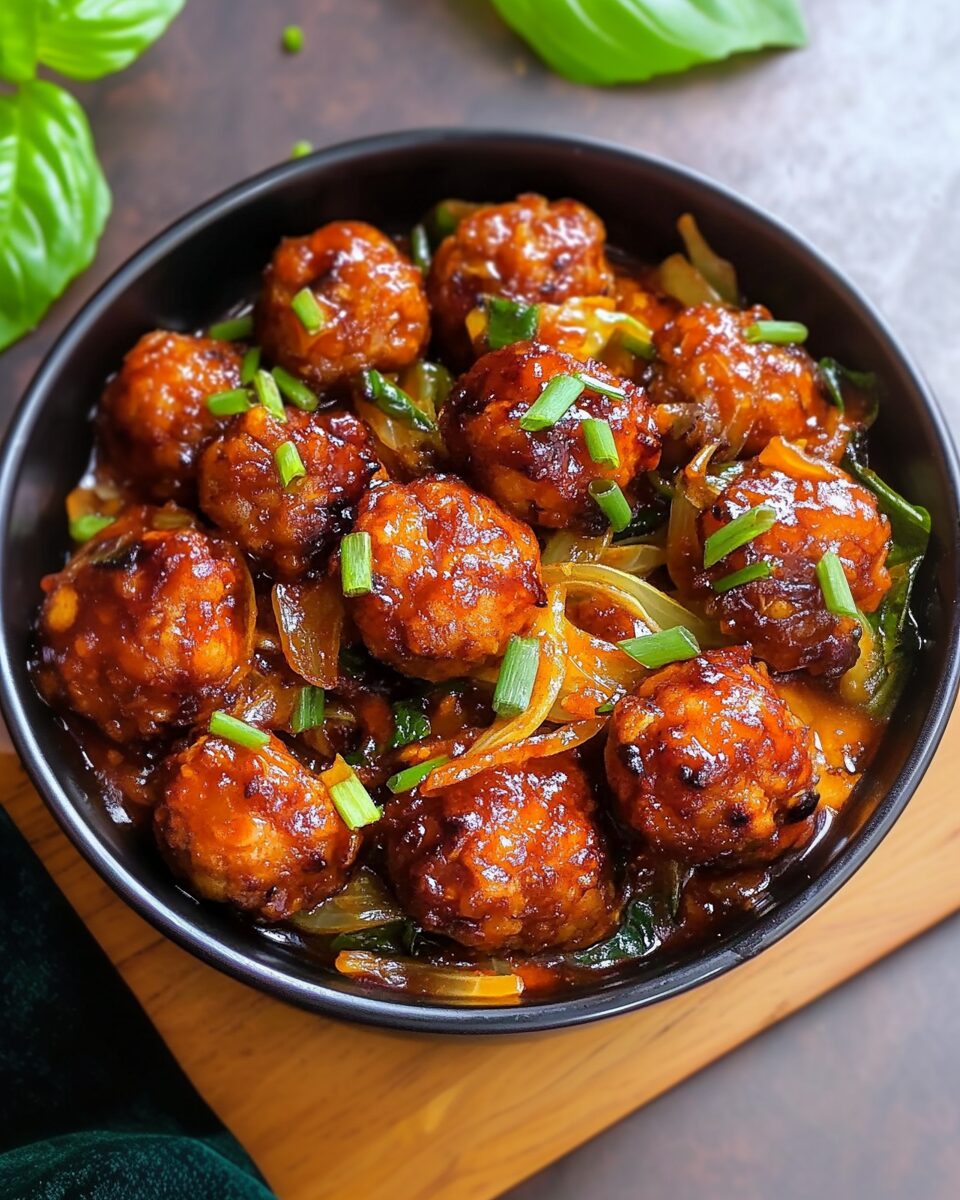Cabbage Manchurian is a delightful Indo-Chinese appetizer that combines crispy fried cabbage balls tossed in a flavorful, spicy sauce. It’s a popular street food choice, offering a crunchy exterior with a soft interior, making it a favorite among vegetarians and non-vegetarians alike.
Full Recipe:
Ingredients
For the Manchurian Balls:
- 3 cups finely chopped cabbage
- 1 teaspoon chili powder
- ½ teaspoon pepper powder
- ½ teaspoon salt
- 1 teaspoon ginger garlic paste
- ¼ cup all-purpose flour (maida)
- 2 tablespoons corn flour
- Oil, for deep frying
For the Manchurian Sauce:
- 2 tablespoons oil
- 1 green chili, chopped
- 5 cloves garlic, chopped
- 1-inch piece ginger, chopped
- ½ onion, chopped
- 2 tablespoons spring onion, chopped
- ½ capsicum, chopped
- 2 tablespoons tomato sauce
- 2 tablespoons vinegar
- 2 tablespoons soy sauce
- 1 tablespoon chili sauce
- ½ teaspoon salt
- ½ teaspoon chili powder
- ½ cup water
- 1 teaspoon corn flour
Directions
- Prepare the Manchurian Balls:
- In a large bowl, combine the chopped cabbage, chili powder, pepper powder, salt, and ginger garlic paste. Mix well, squeezing the cabbage to release its water.
- Add the all-purpose flour and corn flour to the cabbage mixture. Mix thoroughly to form a dough-like consistency. If the mixture is too dry, add a little water; if too wet, add more flour.
- Grease your hands with oil and shape the mixture into small, round balls.
- Heat oil in a deep frying pan over medium heat. Fry the balls in batches, stirring occasionally, until they turn golden brown and crisp. Drain on paper towels to remove excess oil.
- Prepare the Sauce:
- Heat oil in a wok or large pan over high heat. Add the chopped green chili, garlic, and ginger. Stir-fry for a minute until aromatic.
- Add the chopped onion, spring onion, and capsicum. Stir-fry for another 2-3 minutes until the vegetables are slightly tender but still crisp.
- Stir in the tomato sauce, vinegar, soy sauce, chili sauce, salt, and chili powder. Mix well to combine.
- Add water to the pan and bring the mixture to a boil.
- In a small bowl, mix the corn flour with a bit of water to create a slurry. Pour this into the boiling sauce, stirring continuously until the sauce thickens and becomes glossy.
- Combine and Serve:
- Add the fried cabbage balls to the sauce, gently tossing to coat them evenly.
- Garnish with chopped spring onions. Serve hot with fried rice or noodles.
Nutrients
Per serving (approximately 4 servings):
- Calories: 218 kcal
- Carbohydrates: 29 g
- Protein: 5 g
- Fat: 10 g
- Saturated Fat: 1 g
- Polyunsaturated Fat: 3 g
- Monounsaturated Fat: 6 g
- Trans Fat: 0.04 g
- Sodium: 1587 mg
- Potassium: 370 mg
- Fiber: 4 g
- Sugar: 8 g
- Vitamin A: 1352 IU
- Vitamin C: 77 mg
- Calcium: 60 mg
- Iron: 2 mg
Origins and Evolution of Manchurian Dishes
Manchurian dishes, despite their name, do not originate from the Manchuria region in China. Instead, they are a product of Indo-Chinese cuisine, a culinary tradition born from the fusion of Indian and Chinese flavors. The inception of Manchurian dishes dates back to 1975 when Nelson Wang, a cook at the Cricket Club of India in Mumbai, was asked to create something unique beyond the existing menu.
Wang started with basic Indian ingredients like garlic, ginger, and green chilies but innovatively introduced soy sauce and cornstarch, resulting in the birth of Chicken Manchurian. This new creation quickly became a hit, inspiring vegetarian adaptations such as Gobi Manchurian (made with cauliflower), Paneer Manchurian (made with cottage cheese), and ultimately, Cabbage Manchurian.
Cabbage Manchurian emerged as a beloved variant, appealing to vegetarians and those seeking a nutritious yet indulgent treat. The dish embodies the essence of Indo-Chinese cuisine by blending aromatic Indian spices with the signature umami flavors of Chinese sauces.
The Unique Appeal of Cabbage Manchurian
Cabbage Manchurian is distinct from other Manchurian dishes due to its primary ingredient—finely shredded cabbage. This humble vegetable provides a light, crunchy texture that perfectly absorbs the bold flavors of the Manchurian sauce. The dish stands out for its ability to be customized to various taste preferences, making it a versatile choice for both home cooks and restaurant chefs.
The crispy exterior and soft interior of the cabbage balls make each bite a delightful experience. Unlike Gobi Manchurian, which has a denser texture, or Chicken Manchurian, which is meat-based, Cabbage Manchurian provides a balance of lightness and crunchiness. This makes it an excellent option for those who want a flavorful dish without feeling overly heavy.
Nutritional Profile of Cabbage Manchurian
While Cabbage Manchurian is a delicious treat, it is important to consider its nutritional aspects. A typical serving contains approximately 218 calories, with a breakdown as follows:
- Carbohydrates: 29g
- Protein: 5g
- Fat: 10g
- Dietary Fiber: 3g
- Sodium: Varies depending on the amount of soy sauce used
Cabbage itself is a nutrient-rich vegetable packed with Vitamin C, Vitamin K, and dietary fiber, all of which contribute to overall health. However, the deep-fried nature of the dish increases its calorie and fat content. For those who want a healthier version, baking or air-frying the cabbage balls can significantly reduce the oil content while maintaining the dish’s signature crispiness.
Variations and Serving Suggestions
One of the best aspects of Cabbage Manchurian is its versatility. Whether you prefer it dry or with a flavorful gravy, the dish can be tailored to suit different dining occasions and preferences.
- Dry Cabbage Manchurian: This version is perfect as an appetizer or snack. The crispy cabbage balls are coated in a thick, spicy sauce that clings to the surface, offering a bold, concentrated flavor. It pairs well with a side of mint chutney or schezwan sauce.
- Gravy Cabbage Manchurian: This variation transforms the dish into a main course, ideal for pairing with steamed rice or noodles. The sauce is made slightly thinner, allowing it to coat the cabbage balls and infuse them with a rich, tangy taste.
For additional flavors and textures, vegetables such as bell peppers, carrots, and spring onions can be added. Some even like to introduce a hint of sweetness by incorporating honey or brown sugar into the sauce, balancing the spiciness with a touch of caramelized flavor.
Cooking Techniques and Healthier Alternatives
Cabbage Manchurian is traditionally deep-fried to achieve its signature crispiness. However, there are several alternative cooking methods that allow for a healthier preparation while maintaining taste and texture:
- Baking: The cabbage balls can be baked at 375°F (190°C) for about 20–25 minutes until golden brown. This method significantly reduces oil intake while still providing a satisfying crunch.
- Air-Frying: Using an air fryer at 375°F (190°C) for 15–20 minutes achieves similar results to deep-frying with minimal oil.
- Shallow Frying: Instead of deep-frying, the cabbage balls can be cooked in a small amount of oil in a pan, reducing excess fat.
While deep-frying gives the best texture, these healthier alternatives allow individuals to enjoy Cabbage Manchurian more frequently without compromising their dietary goals.
Cultural Significance and Popularity
Indo-Chinese cuisine has firmly established itself as a staple in Indian street food culture. From roadside stalls to high-end restaurants, Manchurian dishes, including Cabbage Manchurian, are widely available and loved by people of all age groups.
The popularity of Indo-Chinese food stems from its bold flavors, vibrant colors, and satisfying textures. It is often served at gatherings, celebrations, and special occasions, making it a dish that brings people together. Cabbage Manchurian, in particular, has found its place among vegetarian and vegan communities as a delicious alternative to meat-based Manchurian dishes.
Tips for Making the Best Cabbage Manchurian
To achieve restaurant-quality Cabbage Manchurian at home, follow these expert tips:
- Finely Chop or Grate the Cabbage: This ensures that the cabbage binds well with the batter, creating evenly shaped balls that hold their structure.
- Remove Excess Water from Cabbage: After chopping the cabbage, squeeze out excess moisture to prevent the batter from becoming too loose.
- Use Cornstarch and All-Purpose Flour: A combination of these two flours helps achieve the perfect crispiness.
- Maintain Oil Temperature: If the oil is too hot, the exterior will burn while the inside remains undercooked. If it’s too cool, the cabbage balls will absorb excess oil and become greasy.
- Toss the Fried Balls in Sauce Just Before Serving: This prevents them from turning soggy, preserving their crunchiness.
Conclusion
Cabbage Manchurian is a remarkable fusion dish that captures the essence of Indo-Chinese cuisine. With its crispy cabbage balls coated in a flavorful sauce, it has won the hearts of food lovers across the world. Whether served as an appetizer, snack, or main course, it remains a versatile and delicious choice for any occasion.






